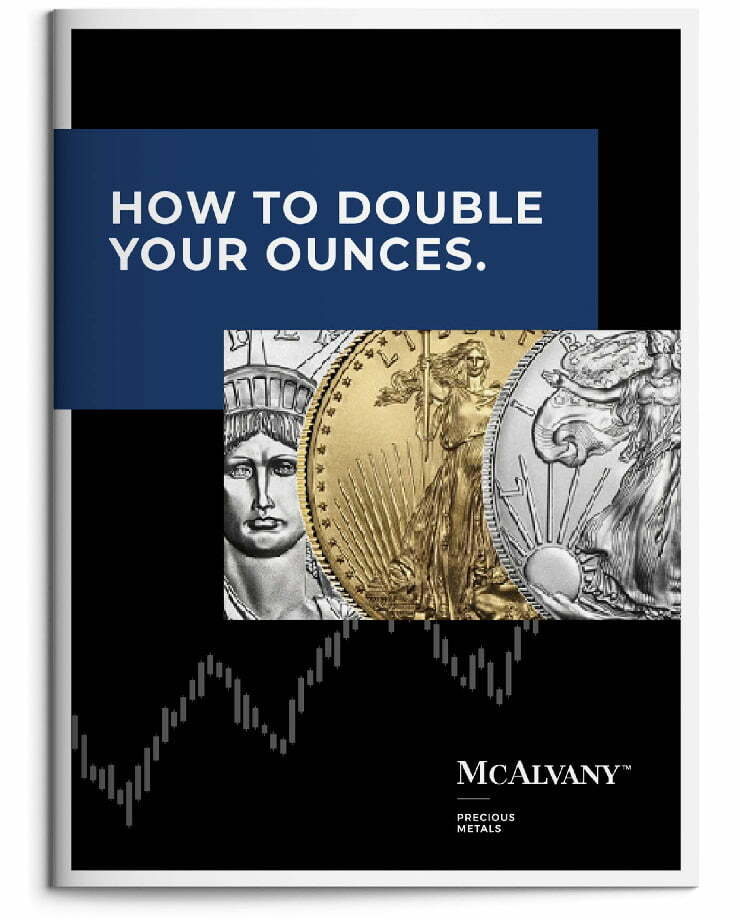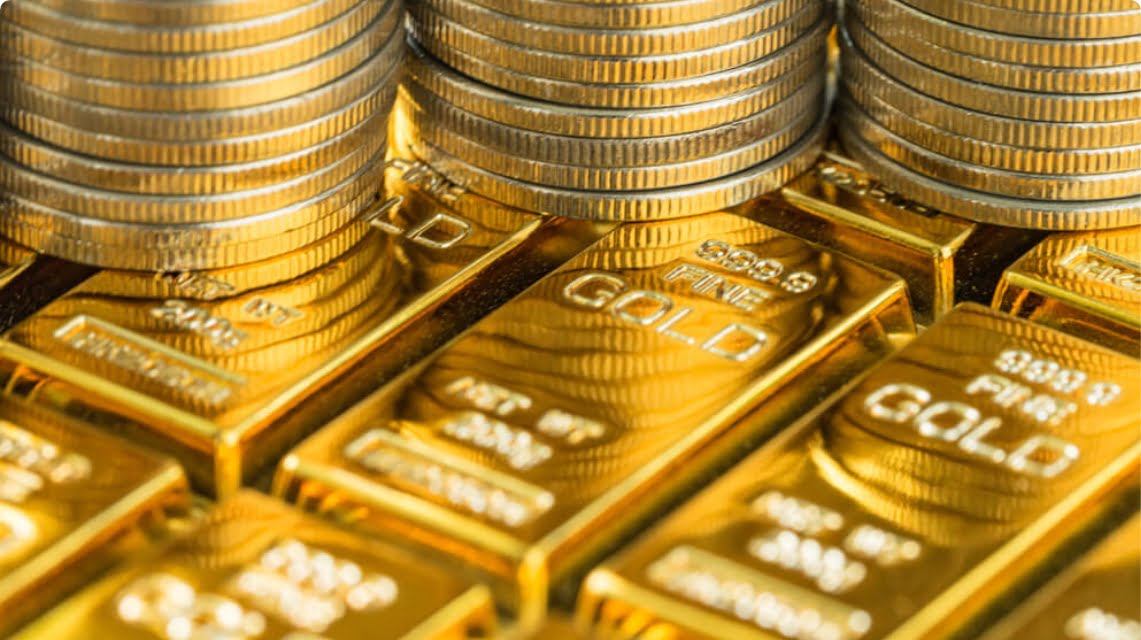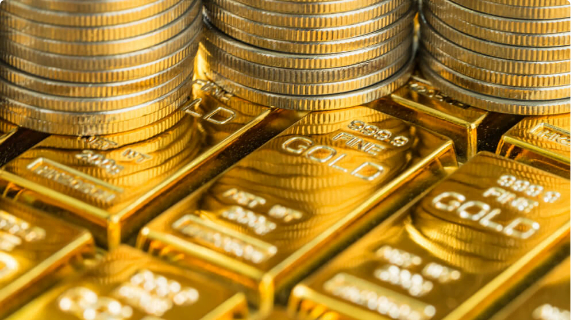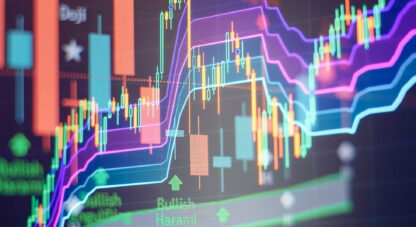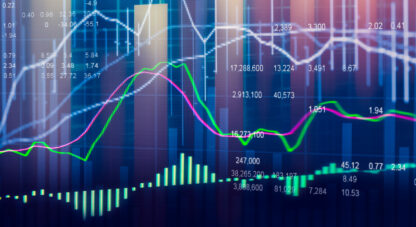Podcast: Play in new window
- A Currency On Its Way To Zero Reprices Assets To Infinity
- Citadel’s Ken Griffin: Investors View Gold Safer Than The Dollar
- Debt Trap: The Only Way Out Is To Inflate
“Only once in world history have we had a unified fiat system in which investors base their allocations on a system whose ground is inherently shifty, constantly moving. The euro is only as strong as the ECB and its credibility. The pound sterling is only as strong as the Bank of England’s credibility. The yen is only as strong as the Bank of Japan’s credibility. The dollar is only as strong as the Fed’s credibility. It is a global fiat confidence game, and confidence is a fragile thing.” —David McAlvany
* * *
Kevin: Welcome to the McAlvany Weekly Commentary. I’m Kevin Orrick, along with David McAlvany.
David, I called my mom this morning and I said, “Do you remember when I was in third grade? I had Mr. Cook as a homeroom teacher. And he had been a gold miner before he had become a teacher, and so he started something called the Gold Club.” This was a memory that just came to me this morning, and I remember we had a field trip to, I think it was Cripple Creek, and we panned for gold, just a bunch of third graders. I came home with this big bag of black dust that I hoped had an ounce of gold in it because I thought, “Wow, maybe I could get 40 bucks for it,” because gold was just about that price at the time.
And then I had another memory, Dave, that back in the mid-’90s I was a guest at the trading floor of the World Trade Center, the commodities exchange there. And someone was trying to sell a gold contract for 10 times that, an August contract for 400, and he would walk up to the outside of the circle and he’d hold up his hand as if he was trying to sell it, and he would say, “Augie at aught.” August contract at 400—double zero. Here we sit today, Dave, and we’re looking at December contracts being a four with three zeros after it. So from 40 when I was a third grader to 400 back in the mid-’90s, to four with three zeros after it. I mean, what does that say?
David: I woke up to a Bloomberg headline this morning about gold, and Citadel’s Ken Griffin was observing that investors are starting to view gold as a safer asset than the dollar.
Kevin: This is Ken Griffin, the guy who’s into high-frequency trading?
David: Absolutely. So a development that’s, in his words, “really concerning.”
Kevin: Well, for him, yeah.
David: It was kind of a vague observation. Is the concern about investors, is the concern about the state of the dollar? Is it the role of gold? More to the point, is there a little concern for the Citadel franchise, which requires a frenzied level of trading for his company, a market maker, to pinch its billions in profit, which has come of age in a period where cheap credit, excess leverage and a casino mentality have gone hand in hand? There is a franchise risk for Griffin. When people look behind the derivatives and products you match orders for and begin to second-guess the currency that they’re priced in.
Kevin: In a way it reminds you of sports gambling or gambling in Vegas. I mean, he really has made his money because of a lot of gambling chips, wouldn’t you say? It’s a little like casino currency?
David: And to be fair, you could say, well, he facilitates liquidity in the market, which is a generous way of describing what he does.
Kevin: He’s a philanthropist. Yeah.
David: He is, with the billions that he makes from facilitating liquidity. But certain things you would like to take for granted, and a currency’s value is one of them. Economic energy, when that gets put into hedging one’s wealth, that’s economic energy that could have been allocated to growing one’s wealth. And here’s the rub. The really concerning aspect of gold being seen as safer than the dollar is that a man of Griffin’s stature could have implored Republicans and Democrats alike to go easy on fiscal policy.
Kevin: Austerity. Yeah.
David: And the monetary policy laxity, which in the fullness of time begins to compromise the integrity of the currency, changes the risk in US-denominated investments. But no, that was not what Ken Griffin did. He did not approach them, lobby them, and suggest “You’re creating an unstable environment, you’re creating an unstable currency. You create a bubble, and guess what happens on the other side of it? There’s a tremendous amount of wealth that is lost to a lot of unsuspecting investors.” He did not implore them.
Kevin: Of course not. His favorite movie is Some Like It Hot, and they’re running this thing hot. That’s how he makes his money.
David: Yeah, I think this sort of “concerning development,” it was visible in the early days of Citadel’s creation. That was two decades ago. And this is really what created an opportunity for him. Decimalization was introduced, and the old market makers were run out of town, replaced by the digital, high-frequency-trading, black-box models that groups like Night Capital and Citadel—and now Jane Street—the kinds of programs that they run.
Kevin: So when you talk about decimalization, let’s talk about that for a minute, because that was actually a big event when it happened. It didn’t sound like it, but stocks used to trade in fractions.
David: Fractions, yeah. It traded in fractions. It’s less efficient, obviously. Harder to work from a computer model with fractions than it is decimals because decimals you can run out to near infinite degree.
Kevin: And then you can arbitrage on those infinite degree decimals.
David: Yeah, and the market makers had very fat profits because of the inefficiency in pricing with fractions. So the old market makers lost their franchises and were replaced by the new market makers who had the whiz-bang computers to trade in decimals. And I mean it really was—
Kevin: And 500 trades a second, that type of trade.
David: Or even more. But to be honest, it peeves me just slightly when a man whose fortune was built by high frequency trading and market making— It depended on the likes of Jerome Powell and Janet Yellen and Ben Bernanke setting the monetary stage for his franchise success, a company with profits that are pushed onward and ever upward by policy accommodations. And of course these are policy accommodations not just to him, but to Wall Street in general, to Main Street traders as well. But markets inebriated by the near infinite flows of liquidity and cheap credit—how is he surprised that gold would reflect the inherent weakness of the system? That’s a little irksome to me.
Kevin: Well, and gold tells the truth. I mean, gold does reveal truths that a lot of people don’t want us to know. It reminds me of a conversation I had with someone the other day. They had skeletons out, they had decorated for Halloween, and they said, “What do you think about bones?” And I said, well, one of the things I like about bones is they tell the truth. Okay, 200 years from now, a man’s skeleton is still going to be a man’s skeleton, and a woman’s skeleton is still going to be a woman’s skeleton.
David: There’s not a lot of ambiguity there, is there?
Kevin: No. There might be when they’re alive, but not after they’re dead. And gold is like that. Gold tells the truth when we’re going to run it hot.
David: Yeah, gold is an inconvenient tell. And our financial system and Ken’s financial empire, it depends on trust. So when trust erodes more than the dollar gets reappraised, you’ve got counterparties which are reappraised. And that’s the uncomfortable part for Ken because he’s the counterparty. Counterparties, that’s what reappraised when the dollar’s suspect, when gold is on the move. That means you. No one cares about the currency or counterparty risk until they do.
Kevin: And you don’t need to, with gold. I mean, obviously.
David: Right. And then, when the market is concerned about counterparty and currency, it’s a concern that you can’t quickly remove from view. So, in essence, when gold becomes viewed as a safer haven, a safer asset than the dollar, institutional trust has already eroded to a level for that particular cycle, and it’s irreparable.
Kevin: So does this signal, Dave, the end of a bull market? In all the things that Ken is making his money in, are we at the tail end of that when we’re starting to call gold more valuable than the dollar?
David: I think there’s other things that you could point to as sort of signaling the end of a bull market. The bullish narrative is slipping. Options, volumes, and equity trading, which is all Ken’s world, are bumping up against the hard wall of valuations. And valuations are not a timing mechanism, but they certainly tell you what neighborhood you’re in. And so, other things like dividend yield—the S&P dividend yield dropped to 1.17%, you’ve got a price to sales ratio on the S&P of 3.3 times. That’s the same index for the S&P. And these are things that say you’re at the end of the road. You’re at the end of the road.
Kevin: Well, unless Powell does something radical.
David: Correct. It’s the end of a bull market unless Powell and Company can keep the Citadels and Knight Capitals and Jane Streets alive by keeping liquidity flowing. A weak dollar may well keep the traders trading. But there should be no surprise that in an interconnected financial market—that is, a global financial market—hedging currencies and hedging currency risk, hedging counterparty risk with gold, has become popular, it will continue to become more popular. No surprise there.
Kevin: Yeah, but what’s strange Dave, right now, is you remember the late-1970s. There was fear buying of gold when it ran to 850. And we had fear buying of gold actually after the 2008 global financial crisis. Do you feel any fear at all in this move on gold right now?
David: No. Specifically on gold, there is no fear in the trade. There is no squeeze in supply. What we had in 2008 was indicative of people saying, “I’m done. I want out.” Whether it’s out of currency, out of stocks, what have you. I mean, there was a pretty big move to bonds in the cycle.
Kevin: “Run away, run away,” was what they were saying. Yeah.
David: Yeah. This time is different. And by that, I mean advanced prices and gold are typically driven by palpable fear and a lack of supply, or not enough supply to meet demand. And perhaps we’re safe to assume that we’re not as far along in a gold bull trend as many assume we are, based primarily on where the price is at. Fear will become dominant, and there will be a vocal factor in that, and supply will run thin. But here we sit at 4,000 an ounce, and supply of either gold or silver in any denomination or any quantity can be had at the lowest premiums we’ve seen in decades. Recall 2008, we were taking orders in November and December, and you had to pay significant premiums for immediate delivery.
Kevin: And we had very limited supply, Dave.
David: That’s right. And if you wanted the current gold price at that time, you didn’t have to pay premiums as long as your purchase in November/December could be on hold and delivery could be made March, April, or May of 2009. Of course, again, this is an indication of palpable fear. People would say, “I don’t care what the price is, get the metal in my hands now.”
So again, we don’t have that. We don’t have a line of people purchasing. We don’t have an issue with supplies. The wholesale market is amply supplied. What do you want? In what quantity? Do you want to spend a million dollars? You want to spend $10 million? You want to spend $50 million?
Kevin: Plenty of inventory right now.
David: There is no quantity of purchases that can’t be put into the market today. Which, again, is ironic because at $4,000 an ounce, you would think premiums have got to be high, volumes have got to be through the roof. Not the case.
Kevin: Okay, so the story that I told about gold panning when I was in 3rd grade, that was just about the time your dad started this firm, 53 years ago. And with that thought in mind, $40 was an all-time high on gold. And then in the mid-90s when I was at the World Trade Center, $400 wasn’t an all-time high, but it was a new high for gold after many years, and now we’re at 4,000.
David: Quick question for you on that.
Kevin: Okay, yeah.
David: If you were of a mature mind at that age, and someone asked you the question, could you imagine this $40 gold price— Could you imagine the price of gold moving that much in a given day? It’s a $40-an-ounce asset. Some day, Kevin, this will move $40 or more in a day.
Kevin: Oh, yeah.
David: You could chuckle. You could laugh.
Kevin: That is incredible. Okay. So let me ask you the question. For the person who, honest to goodness, they’re looking at $4,000 gold and they’re saying, “All right, well, I’ve owned gold for years. Should I start taking some profits?”
David: Yeah, I get that long-time investors sell into prices they’ve never seen before. I think the funny thing is, when investors buy a company, they buy productivity, they buy creativity, they buy an expansive view of the future, expanding market share, et cetera, growing a product line globally for distribution purposes. There’s no caps on imagination. So what’s the limit to a price when you’re buying a company? Buy something at $10, it could trade to 20, 200, 2,000. There’s no limit on imagination.
Gold investors may subconsciously cap the price they see the commodity trade to, because there’s no inherent growth story. But shouldn’t the ever-true fiat fact—this is just a reality when it comes to fiat currencies—shouldn’t the ever-true fiat fact be kept close at hand and fresh on the mind, a currency on its way to zero reprices real assets towards infinity?
Kevin: Absolutely. You think about it, Dave. You think about the German mark back in the 1920s, how strong it was back in 1914 before the war, and how billions and billions of German marks wouldn’t even buy a chicken for dinner at the end of the run. So one of the things that I think we all need to remind ourselves is there’s never been a currency in history—in the history of mankind—not backed by gold that didn’t fail completely. I mean, utterly and completely. All currency goes to zero.
David: There’s also never been a time in the history of the world where every currency was fiat, as it is today.
Kevin: That’s true. That’s true. Nothing is backed by anything.
David: Right. So we’ve got zero reference points for value in the monetary system because everyone is on a fiat system. So the story of gold price appreciation is the story of the dollar in terminal decline. You ask, how high does the gold price go? And I ask, how low does the US dollar go? So investors are figuring out that wearing the cleanest dirty shirt still leaves you looking homeless and ragged. And so their appreciation for the dollar as the cleanest dirty shirt, now I think they’re sort of sniffing and saying, “Yeah, this kind of stinks.”
Kevin: Yeah. But what if you change from your dirty attire to gold?
David: Preference for gold is building, and I think it’s to the detriment of the Wall Street trader, to the detriment of neo-Keynesians, who both would like every dollar in liquidity churning through the economy, churning through their trade platforms.
Kevin: Modern Monetary Theory.
David: Ken doesn’t care about valuations. He is dependent on flows, so volumes matter. And if money is diverted from a system of churn and burn, he loses that potential income. So when he sees gold competing with the dollar, he does have to feel the pressure of it ultimately—
Kevin: It’s affecting his business.
David: —compromising his franchise.
Kevin: Yeah, absolutely.
David: He’s dependent on flows. He cares greatly if speculative flows shift in the direction of a safe haven. In some sense, he’s like an old riverboat captain on the Mississippi. Without the flows of liquidity, you can’t service the farmer, the tourist, anyone else looking to ride the flow.
Kevin: So when I told my son this story this morning, I said, “Yeah, I called your grandma and I told her the story of my gold panning day in 3rd grade.” By the way, I lost my sandwich that day. My mom packed me a sandwich, it dropped into the river. And speaking of flow, okay—
David: There it went.
Kevin: Went right down the river. And I’ll never forget, that was a tragedy to me in 3rd grade to miss lunch. I was hungry and I was cold, came back with a bag of dirt.
But gold was 40, okay? And then— I told the story about 400. Now it’s 4,000. My son asked this morning, he said, “Do you think they’ll add another zero?” So we went from one zero after the 4, 40, two zeros after the 4, 400, three zeros. We saw that punch through on the December contract on Monday. Could we possibly see, Dave, another zero added, or another zero after that? What’s to stop—? Because we’re not measuring the rising gold, we’re measuring the devaluation of the dollar.
David: And we’re measuring—in the gold price—we’re measuring confidence. So confidence in the system, confidence in the dollar, confidence in the decisionmakers, the managers of the monetary mechanics.
Kevin: Why wouldn’t we have confidence in those guys?
David: If confidence returns, if there’s good reason for confidence to return, we take away a zero. And if confidence continues to be called into question, just add another zero. It’s just marking confidence to market in real time. So, yeah, gold at 4,000, we haven’t seen anything yet. The long-term secular trend is powerfully in play. Doubtless, we see—like we always do in a long-term secular trend—corrections and consolidations.
Kevin: Sure.
David: Now, how deep and for how long, no one knows. Trading in and out, in my view, would be a bad idea. There’s too much at stake in this particular market environment.
Kevin: Okay, so you mentioned something about that. Let’s take silver as part of the equation here, because Ian McAvity was one of our favorite guests. A good friend of your dad’s going all the way back to the early ’70s. Rest his soul, he’s passed, but he was a fun guest to have on. And what did he say about silver as far as what it needs to do to show you where you are in a gold bull market?
David: I think there were years in which he single-handedly kept the revenue stream at Lucky Strike—
Kevin: He did smoke continually, didn’t he?
David: Oh, it was amazing. That’s what makes tobacco profitable.
Kevin: Yeah.
David: Somebody thinking—
Kevin: Well, 9 out of 10 doctors prefer—
David: Camels and Lucky Strike, what was it back in the day?
Kevin: Lucky Strikes, remember those. Yeah, but silver, he would watch silver’s ratio relative to gold, to see where we were in a gold bull market.
David: Right. And we have yet to see silver break out of its ratio range in the 80s. If you want to know a great time to be trimming back positions, I would suggest looking at the ratio as a trigger for the trade, and incrementally doing so. Incrementally doing it when the gold silver ratio gets to 65, then to 55, then to 45 and 35 and so on.
Kevin: And you’re talking about swapping into gold as you’re going, right?
David: Yeah. Swapping to gold as you go. You may be selling metals one or the other at that point, but you know gold tends to be the engine and silver the caboose. So by the time silver is catching up in the trend and then surpassing in terms of performance, you know that you’re getting very mature in the cycle. So the ratio is telling you not only about the silver market relative to gold, but also the maturity of that gold trend.
Kevin: And who’s involved.
David: Right.
Kevin: Right. Yeah.
David: Yeah. And so you get the small scale speculator in the silver market at the tail end, frenzied. And again, in each cycle there are unique dynamics which make it impossible to predict how far the ratio will go, but the ratio is far more important than the price. So you look at $50 silver, $4,000 gold, we’re at 81 to 1 now. We have a lot further to go. The ratio tells you more than the price. That is, again, trading silver to gold, but it’s a good proxy for the energy in the market.
Kevin: So if you ask the man on the street right now, what is the sentiment level for buying gold? Because we’re not seeing what Bill King called the army ants, the general public, coming in and buying. We’re not seeing that right now, but it seems to be there’s a favorable—at least people are seeing in the news that it’s favorable to buy gold.
David: Yeah, I mean, the daily sentiment indicators for gold, there’s a couple of other measures of raw sentiment, which is not necessarily a measure of commitment to the market. Somebody says, “I think gold makes a lot of sense these days.” “How much do you own?” “I don’t own any.”
Kevin: And that’s the case.
David: I talked to a financial advisor just the other day. “I think gold makes a ton of sense.” “What’s your allocation?” “We’ve thought about having up to 5%.” Okay, well, thought about is one thing, and up to 5% is another. Not in step with a Jeffrey Gundlach at 25% or Mike Wilson, as we talked about a few weeks ago, is suggesting the new model should be 60/20/20—60% equities, 20% fixed income, 20% gold.
Kevin: But you still have to move the money into it, right?
David: Right. So I think the contraindicators, the gold sentiment index, one of those indexes is pegged at 100 right now. Bullish sentiment at these levels typically precedes a consolidation, which can either be a correction in price or a sideways movement where the correction is time-based.
Kevin: I think you should repeat that, because you said this in the meeting just about an hour ago, and I thought, “That’s really true. Corrections occur in two ways.”
David: It’s either in price or in time. So we just finished a correction a couple of months ago, the five-month sideways consolidation just prior to this reignition—
Kevin: So it doesn’t have to drop, it just needs to go sideways sometimes.
David: And that can be disappointing for folks who are waiting for an optimal entry point. And so, I mean, you can look at a correction two different ways. If you’re hoping for a correction to give you an opportunity to establish a lower cost basis, maybe you get it, maybe you don’t because corrections take place either with price moving lower or time where you see a consolidation moving sideways and the sentiment kind of bleeds off. It’s not as intense as time goes on, the more time involved.
Kevin: Would you call that building a base? That’s building a base, isn’t it?
David: It can. Yeah, it can. But I mean, typically if you’re in the context of a bull market, yes, that is building a base for the next move. In either case, you don’t have moonshots until the very tail end of a bull market. When prices move on a parabolic basis, that is the end, right?
Kevin: Right. And that’s not happening right now.
David: No. You should welcome corrections along the way, either in price or in time, and recognize that there is— We’ve often talked about the rate of change. When you start to see the rate of change in a 6 to 12-month period over 150%, you’re getting close to the end. So people look at a gold move, year to date, 45, 50%. Silver now over 60%. Wow, this looks parabolic. No, that’s not the way it works. If you’re stacking in triple digits in less than a year, then we should talk, but also match that against what’s happening with the gold/silver ratio—again, to know what the pricing dynamics are, and what that tells you about mood and ultimately the end point.
Kevin: Right. And this is a strange market because it’s the central banks that have really been pushing gold up. So I asked a client last week before he put a fair amount of money into the gold market, we talked about is it possible that we’ll have a correction? It was like 10, 15% correction. Could we have that? And the question that I asked him, and he immediately jumped on, I said, “Well, who do you think will buy that gold if it drops 10 to 15%?” And he goes, “The central banks.” And he’s exactly right. Central banks are not playing the price right now, they’re moving out of the dollar.
David: Right. And I think that’s one of the things that we found in the last five-month period of sideways consolidation, is that every time there was downside pressure, there was aggressive buying, and the price would not recede. So again, it tells you that there are significant buyers who want to get allocated, and they didn’t do it for a three to four hundred-dollar move, right?
Kevin: Right.
David: So the move from 3,400 to 4,000, the $600 move, they didn’t buy gold as a $600 trade, they bought gold as a de-dollarization trade—
Kevin: That’s a great point.
David: —and that’s something that has years to play out. This is a policy train wreck, a fiscal policy train wreck, both here in the US, in Europe, in Asia, which is playing out, and it is a slow-motion train wreck. And anyone who’s buying gold in light of the strongest fundamentals we frankly have ever seen supporting the gold market, they’re not doing it on the basis of: we made a quick buck, now let’s cash in. There are traders who will add volatility on that basis, but they’re also the ones who will be left on the sidelines hoping for the correction to reestablish a position that never moves their direction.
Kevin: Yeah, so de-dollarization is the key.
David: Would I buy it now? I would let the froth come out a bit, $4,000 and $50 on silver, those are prices that traders have targeted, and a number of in futures traders will lighten up at those levels. Having said that, I’ll be adding, regardless, this month, and here’s my history of purchases at interim highs: 350—
Kevin: Don’t you wish?
David: —475. These are all interim highs. This is not, I bought the best price ever.
Kevin: These are places that you purchased, and you have record of.
David: Yes. And they were all interim highs, not, “Oh, I bought the dip. I bought the dip. I bought the dip.” I paid 350. I paid 475.
Kevin: I remember when you paid 350.
David: 550, 750, 900, 1100, 1650. 1850 was the highest price I had paid for a long time, and I did it under duress because my dad came and said these one and two ounce gold medallions, which we started the company with back in the 1970s, which made the religious exemption, they were religious medallions, which allowed us to sell bullion before it was actually legal to own bullion.
Kevin: I know those, yeah.
David: And he’s got a complete set, and he’s like, “I’m selling them. I want maple leafs and I’m taking maple leafs to Asia.” And I’m like, “You’re doing what?”
Kevin: And it’s like a museum piece for the company. I mean, it really is the founding of the company.
David: That’s right. He’s like, “Well, if you want them, you can have them and I’m like, I generally do look at the price and say, “Could I be—”
Kevin: And you’re like, 1850.
David: 1850. I’ve never paid that price before.
Kevin: That’s rich. That’s rich.
David: It is rich. Yeah, 2200, 2800, 3200, 3600. How am I doing? This is my track record of buying gold through the years. And as we march towards 8,000 an ounce and perhaps higher, I’ll incrementally add, and I’ll incrementally trade the ratios and the premiums for an increase in ounces along the way. You won’t find me lightening a gold position significantly until the Dow/gold ratio is in the low single digits.
Kevin: And let’s talk about that because that’s such a critical tool.
David: Yeah. We’re at 11.6 today. And to look at being in gold today and having on the horizon this notion that you can spend your ounces for something of high value that is selling in a moment of despair at a discount. 11.6 is the ratio today. We started the year closer to 15 to 1, and the pickup in value relative to equities getting to the historic ratios is in the range of 400% to 1100%.
Kevin: Which is how many more stocks you can buy later than you could buy today.
David: That’s the scale of my equity portfolio funded with gold at those levels. So we’ve discussed this repeatedly, but where else do you put money today? Shifting a gold allocation to the S&P today? No. To the Dow today? No. Not a chance.
At six to one, yes I’ll begin the process because these are processes that you have to do on an incremental basis. At five to one, yes. At three to one, yes. At one to one, you’d be foolish not to, but that is years ahead. At a minimum, one to three years. At a minimum, and I don’t have a crystal ball. Maybe it’s more than that.
Kevin: Well, and Bill King last week, I loved what he said. Everybody loves Bill King for his honesty. This is a stock and sometimes bond guy. But right now he’s like, “Where else do you go but gold?” And so the anticipation that what you’re talking about, Dave, is being able to buy, you call it enlarging your investment footprint, and that’s exactly what you’re trying to do right now with gold. Stay in gold long enough to enlarge your investment footprint. You’ll never sell all your gold. But what you’re talking about is selling enough to go back into stocks at a single digit ratio.
David: I think one of the differentiators in the market, our company versus other competitive companies, is that they sell a widget at a margin and that’s it.
Kevin: What do you want? Send me the money.
David: We have the context and a strategy for navigating across a business cycle—a complete business cycle, the ups and the downs—and have experience doing it. And so to talk about the Dow/gold ratio, to talk about the premiums that come and go with particular products, and to be able to compound ounces along the way, that is not a value-add you find anywhere else.
So I am bullish on gold and silver, but I also am cognizant of the fact that in the fullness of time there are once-in-a-generation opportunities to migrate some ounces—not an exit strategy from gold, but a reduction strategy. And this is what King was expressing last week. He started with a 20% allocation.
Kevin: Now it’s 50.
David: And now it’s 50. Well, so what is a reasonable allocation? As gold continues to move higher and as a percentage of his portfolio approaches 70, do you reallocate at some point? What I’m suggesting is that there are ratios that help you know when that’s propitious to maximize value along the way. So we’re not there yet. Buying in the metals has still been, over the last year or two, anticipatory. Whether it’s the central banks or family offices, high net worth individuals, it’s been led by a minority of investors.
Kevin: Not the army ants, yeah.
David: Yeah. Bill King described the army ants in last week’s Commentary as largely absent from the metals market. But as more begin to enter, you know what is common? A correction. Super healthy. Buy it. Be happy with the ounces you own, add on corrections.
Be mindful, however, that this bull is driven by global fundamentals unlike anything we’ve ever seen before. A fiscal situation globally unmatched by anything in history, a fraying of geopolitical relations only seen during the 1914 to 1917 period, that timeframe, and again in the 1940s.
Only once in world history have we had a unified fiat system in which investors base their allocations on a system whose ground is inherently shifty, constantly moving. The euro is only as strong as the ECB and its credibility. The pound sterling is only as strong as the Bank of England’s credibility. The yen is only as strong as the Bank of Japan’s credibility. The dollar is only as strong as the Fed’s credibility. It is a global fiat confidence game, and confidence is a fragile thing.
Kevin: And it takes that flow that you’re talking about: debt. I mean, how many trillion in debt are we worldwide? You have to have that flow of liquidity, and that flow of liquidity is made up with currencies that you just named.
David: Global debt at 338 trillion, I think is the number. 338 trillion.
Kevin: Wow, wow. So 338 million, million. That’s nada much.
David: Million, million.
Kevin: That’s nada much.
David: It requires a lot of cash flow to maintain. And now you’ve got the 114 trillion in global GDP. So debt relative to GDP, not a healthy ratio.
Kevin: Almost three times, and that’s including government, isn’t it? Isn’t that including government spending?
David: I think it’s fair because government doesn’t really create anything. You create, they take and spend, which actually does get factored into GDP, but they’re not creating anything.
Kevin: So, the private sector, how much do they produce?
David: 30 to 40% of global GDP is government spending. The remainder would be private sector. So arguably, government’s not the engine of growth. It’s important to the total equation, but it’s not a dynamic source of growth. I think it’s worth considering that 80 trillion in private sector activity is what supports the 338 trillion in debt.
Kevin: So if you just take the private sector, the—
David: GDP.
Kevin: —global debt is four times what we’re producing worldwide.
David: Yeah, about four and a quarter times. So currency values, interest rates, when you think about the debt in the system and the amount of GDP growth it takes to just maintain it, all of a sudden currency values and interest rates, you realize they’ve never been more critical. You look at what central banks are tasked with doing. Whatever mandate or mandates they have, fighting a recession is an imperative for all central banks around the world, because to lose tax revenue with this quantity of debt is not tolerable, is not sustainable.
Kevin: You got to keep the money flowing.
David: It’s game over. So, to see rates increase, also intolerable. Back of the napkin estimate: $10 trillion in debt service. Again, this is 2.5% on average. Actually, it’s much higher than that, but let’s just say 10 trillion. 10 trillion in debt service, those costs, that’s the equivalent of 12.5% of global private sector GDP, and that’s what’s required every year for debt service. Trump is something of a global standard-bearer here. Whether you like him or not, just know that he represents a way that it has to be done. We have to run the economy hot. We have to. Everyone needs GDP growth to stay in front of their growth in debt and their debt service costs. This is not just a U.S. problem, and this is one of the reasons why it’s not just U.S. demand for gold.
Kevin: So, it’s a fait accompli. In other words, running it hot. I made the joke about the movie Some Like It Hot, but we need to keep that in mind because if we know they’re going to have to run it hot, we’ve got to continue to own gold. I mean, what else do you do? Like what Bill said last week, what else do you— Where do you go?
David: Knowing that this is a tall order, it’s not a surprise to see investors allocating to gold.
Kevin: Right.
David: The system is manageable if you can control interest rates. Alternatively, it begins to fray if you have an increase in interest costs, interest expense. So, how do you run an economy hot? You let inflation run hot. You stimulate growth.
Kevin: That’s on the backs of the saver.
David: But when you’re stimulating growth, the net effect is: you are stirring more inflation. And yes, that’s not lost on savers. It ties directly to a growing investor preference for gold over dollars. So, to Ken’s earlier point, it’s not just dollars. If you’re in Japan and looking at a new prime minister being installed that is a Shinzo Abe protege with inflationary pressures building, rates on the increase, does the Japanese saver think about diversification to gold from yen? Yes.
Kevin: They better.
David: Is it different in China? Is it different in the eurozone? The global trends are somewhat uniform, as is the migration to gold. We’ve never had this setup before. So, would I buy at 4,000? Yes. Would I be selling at 4,000?
Kevin: No. No, because we keep adding zeros to the four, right?
David: Yeah. I mean, fiscal crisis and the threat of inflation and financial repression in the U.S. alone would be sufficient to catalyze a massive bull market in precious metals. To have these threats on a global basis is a unique bull market dynamic, one that has never existed before. Layer in a degree of instability in financial assets—a bond or an equity bear market—and you have yet another major catalyst for diversification into gold. Self insurance.
Kevin: Okay, but let’s take a different tack. Back, remember 10 years ago, the European crisis, actually, it’s about 12 or 13 years ago. The idea was austerity. If you just incorporate austerity, you can solve this problem, and that’s a not-running-it-hot solution. Do you think that could actually happen?
David: In France, it’s so interesting. They used to say, “Let them eat cake.” They’re about to say, “Let them eat macarons.” I do like macarons, by the way. They’re delicious. It’s my daughter’s favorite dessert. Those little— They look like sandwiches, but they’re crispy and—
Kevin: Oh, yeah. I was thinking of the nut macaroon, but you’re talking about macarons.
David: Yeah. Well, but Macron is about to get thrown out, but he may well be on his way out the door. His prime ministers have failed to convince the French public that austerity is a reasonable choice in the face of a fiscal crisis. So if you think about this as a playbook, we have populism popping up all over the world, and an intolerance for austerity. Tax the rich. If you’re French, what percentage of your wealth would you want on the radar versus off the radar? Would you want to define a part of your wealth in terms of ounces—that is, private wealth; that is, portable wealth—as the French tax man cometh? Because he will, because the electorate says that’s the only way forward.
They are not going to cut spending. They are spending too much as a percentage of GDP. The U.S. is actually worse. I think we’re 6.5% of GDP. They’re 5.6%, but they’ve blown past all of the stop signs that the eurozone requires. You can’t do this. They’re like, “Well, we did. What are you going to say about it?” Vive la France.
Kevin: So, you were talking about taxes though. If you’ve talked to a French person with assets recently, they’re not only concerned about the devaluation of a currency. They’re concerned about the confiscation of their assets based on the threat of war with Russia. That’s actually what’s being promoted right now.
David: Well, national duty.
Kevin: Exactly.
David: Wealth insurance in a time of fiscal operators being desperate to fill gaps, what would you do? It doesn’t matter if you’re in France or in Iowa. Sit with millions at BNP Paribas or Société Générale in euros? How about millions with B of A and Wells Fargo? How about bars in a vault? That’s where I’m comfortable.
Kevin: So when governments get desperate, they’ll do whatever they need to do.
David: It’s taxes. It’s inflation. It’s repression. These are their powerful tools. When they’re desperate, that’s the version of the gloves have come off: taxes, inflation, repression. You don’t think governments around the globe would brandish those tools? Think again.
Kevin: No, of course.
David: In that sense, Kevin, wealth insurance has never been more important. What’s the price that you’re willing to pay to insure your wealth? We talked about this a few weeks ago. Forest fire just over the hill, and you’re trying to insure your property. Guess what? The price of insurance just went up. Is it more important or less important because the price went up? The price is the price. Do you want wealth insurance, because the fires are raging and these are fiscal fires? It’s not just in the U.S. It’s global.
Kevin: Well, okay, so I became a grandpa a year and a half ago, and I think different, Dave. They said I would, and I do. I think different. My heart grieves for my kids, my grandkids when I see the prices going up. I mean, I’m not celebrating $4,000 gold. I’m just telling you right now. I wish it was still 40 and that we had a system that was based on a gold standard. So, the cost of everything is getting to the point where I just don’t know how it’s sustainable for people who aren’t making enough to live just on a day-to-day basis.
David: Well, let me give you a practical input, a personal anecdote. I’ll close with this, a dog anecdote. We lost our dog in July.
Kevin: That is one of the hardest days.
David: Congestive heart failure. We are replacing her now. The original purchase was 2018.
Kevin: So, your dog was not very old. That was, what, eight years ago? Seven years ago?
David: Yep. We’re replacing her now, 54% more expensive from the same breeder since our last purchase in dollar terms from 2018 to the present.
Kevin: So, in seven years, 54% increase.
David: 54% more expensive. You know what? I don’t save in U.S. dollars. I save in ounces. The dog is 54% cheaper than in 2018 when we purchased our last dog.
Kevin: Almost exactly. Wow.
David: So, I trim back my Vaulted gold position and convert to dollars. I could be paying 54% more. Instead, it’s like shopping with the world on sale. If you’re worried about your retirement nest egg not going the distance in a time of inflation and financial repression, look to gold. Save in ounces.
Kevin: So in a way, you could almost say the world is getting cheaper in gold.
David: It is. It is.
Kevin: Right.
David: The world is getting cheaper in gold ounces, more expensive in dollars, more expensive in euros, more expensive in yen. The choice is a simple one. What currency preference is reflected in your portfolio? I don’t believe the Fed, the ECB, the BOJ, the PBOC.
Kevin: You don’t have trust. Trust.
David: I don’t believe they will steward my wealth wisely. That’s not a speculation. That is a historical fact. I’m an opportunity to them. I’m grist for the mill, and I say, “No, thank you.” Whether it is paying my bills or buying a dog or buying equities, real estate, or considering other investment opportunities on the horizon, the world is getting cheaper in gold terms. It’s a trend I intend to take advantage of. I hope you’ll join me.
* * *
Well, you’ve been listening to the McAlvany Weekly Commentary. I’m Kevin Orrick along with David McAlvany. You can find us at mcalvany.com and you can call us at (800) 525-9556.
This has been the McAlvany Weekly Commentary. The views expressed should not be considered to be a solicitation or a recommendation for your investment portfolio. You should consult a professional financial advisor to assess your suitability for risk and investment. Join us again next week for a new edition of the McAlvany Weekly Commentary.
